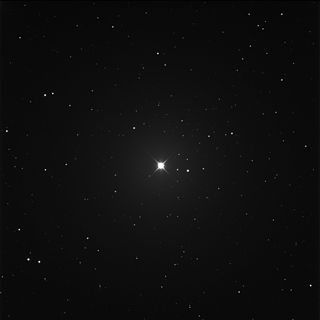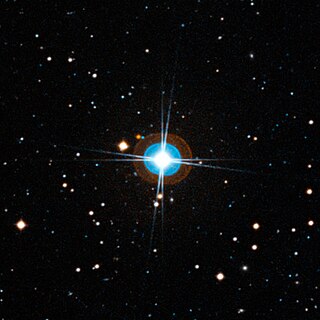Related Research Articles

61 Virginis is the Flamsteed designation of a G-type main-sequence star (G7V) slightly less massive than the Sun, located 27.8 light-years away in the constellation of Virgo. The composition of this star is nearly identical to the Sun.
HD 69830 is a yellow dwarf star located 41.0 light-years away in the constellation of Puppis. In 2005, the Spitzer Space Telescope discovered a narrow ring of warm debris orbiting the star. The debris ring contains substantially more dust than the Solar System's asteroid belt. In 2006, three extrasolar planets with minimum masses comparable to Neptune were confirmed in orbit around the star, located interior to the debris ring.
HD 28185 is a yellow dwarf star similar to the Sun located 128 light-years away from Earth in the constellation Eridanus. The designation HD 28185 refers to its entry in the Henry Draper catalogue. The star is known to possess one long-period extrasolar planet.

HD 28185 b is an extrasolar planet 128 light-years away from Earth in the constellation of Eridanus. The planet was discovered orbiting the Sun-like star HD 28185 in April 2001 as a part of the CORALIE survey for southern extrasolar planets, and its existence was independently confirmed by the Magellan Planet Search Survey in 2008. HD 28185 b orbits its sun in a circular orbit that is at the inner edge of its star's habitable zone.

A Super-Earth is a type of exoplanet with a mass higher than Earth's, but substantially below those of the Solar System's ice giants, Uranus and Neptune, which are 14.5 and 17 times Earth's, respectively. The term "super-Earth" refers only to the mass of the planet, and so does not imply anything about the surface conditions or habitability. The alternative term "gas dwarfs" may be more accurate for those at the higher end of the mass scale, although "mini-Neptunes" is a more common term.

HD 164922 is a seventh magnitude G-type main sequence star in the constellation of Hercules. To view it, binoculars or a telescope are necessary, as it is too faint to be visible to the naked eye. It is 71.7 light-years distant from the Earth. It will soon evolve away from the main-sequence and expand to become a red giant.

HD 192310 is a star in the southern constellation of Capricornus. It is located in the solar neighborhood at a distance of 28.7 light-years, and is within the range of luminosity needed to be viewed from the Earth with the unaided eye. HD 192310 is suspected of being a variable star, but this is unconfirmed.
Pi Mensae, also known as HD 39091, is a yellow dwarf star in the constellation of Mensa. This star has a high proper motion. The apparent magnitude is 5.67, which can be visible to the naked eye in exceptionally dark, clear skies. It is nearly 60 light-years away. The star is slightly larger than the Sun in terms of mass, size, luminosity, temperature and metallicity, and is about 730 million years younger. It hosts three known planets.

HD 40307 is an orange (K-type) main-sequence star located approximately 42 light-years away in the constellation of Pictor, taking its primary name from its Henry Draper Catalogue designation. It is calculated to be slightly less massive than the Sun. The star has six known planets, three discovered in 2008 and three more in 2012. One of them, HD 40307 g, is a potential super-Earth in the habitable zone, with an orbital period of about 200 days. This object might be capable of supporting liquid water on its surface, although much more information must be acquired before its habitability can be assessed.
HD 204313 is a star with two and possibly three exoplanetary companions in the southern constellation of Capricornus. With an apparent magnitude of 7.99, it is an eighth magnitude star that is too faint to be readily visible to the naked eye. The star is located at a distance of 157 light years from the Sun based on parallax measurements, but it is drifting closer with a radial velocity of −10 km/s.
HD 1461 is a star in the equatorial constellation of Cetus, near the western constellation border with Aquarius. It has the Gould designation 32 G. Ceti, while HD 1461 is the Henry Draper Catalogue identifier. This object has a yellow hue and is a challenge to view with the naked eye, having an apparent visual magnitude of 6.47. The star is located at a distance of 76.5 light-years from the Sun based on parallax, but is drifting closer with a radial velocity of −10 km/s.

HD 10180, also designated 2MASS J01375356-6030414, is a Sun-like star in the southern constellation Hydrus that is notable for its large planetary system. Since its discovery, at least six exoplanets have been observed orbiting it, and some studies have proposed up to nine potential planets, which would make it potentially the largest of all known planetary systems, including the Solar System.

An exoplanet is a planet located outside the Solar System. The first evidence of an exoplanet was noted as early as 1917, but was not recognized as such until 2016; no planet discovery has yet come from that evidence. What turned out to be the first detection of an exoplanet was published among a list of possible candidates in 1988, though not confirmed until 2003. The first confirmed detection came in 1992, with the discovery of terrestrial-mass planets orbiting the pulsar PSR B1257+12. The first confirmation of an exoplanet orbiting a main-sequence star was made in 1995, when a giant planet was found in a four-day orbit around the nearby star 51 Pegasi. Some exoplanets have been imaged directly by telescopes, but the vast majority have been detected through indirect methods, such as the transit method and the radial-velocity method. As of 1 October 2023, there are 5,506 confirmed exoplanets in 4,065 planetary systems, with 878 systems having more than one planet. This is a list of the most notable discoveries.
HD 97658 is a star with an exoplanetary companion in the equatorial constellation of Leo. The star is too dim to be seen with the naked eye, having an apparent visual magnitude of 7.76. It is located at a distance of 70 light years based on parallax, but is slowly drifting closer with a radial velocity of −1.6 km/s.
HD 154088 is a seventh magnitude metal-rich K-type main sequence star that lies approximately 58 light-years away in the constellation of Ophiuchus. The star is orbited by a hot Super-Earth.
HD 45184 is a star in the southern constellation of Canis Major. It is a yellow-hued star near the lower limit of visibility to the naked eye with an apparent visual magnitude of 6.37. The star is located at a distance of 71.65 light years from the Sun based on parallax. It is drifting closer with a radial velocity of −3.8 km/s.
HD 96700 is the Henry Draper Catalogue designation for a star in the equatorial constellation of Hydra. It has an apparent visual magnitude of 6.51, which puts it below the limit that can be seen with the naked eye by a typical observer. Based upon parallax measurements, this star is around 83 light years away from the Sun. It is drifting further away with a radial velocity of 12.8 km/s.
HD 215152 is the Henry Draper Catalogue designation for a star in the zodiac constellation of Aquarius. It has an apparent visual magnitude of 8.13, meaning it is too faint to be seen with the naked eye. Parallax measurements provide distance estimates of around 70 light years. The star has a relatively high proper motion, moving across the sky at an estimated 0.328 arc seconds per year along a position angle of 205°.
References
- 1 2 3 Díaz, R. F.; et al. (2016). "The HARPS search for southern extra-solar planets. XXXVIII. Bayesian re-analysis of three systems. New super-Earths, unconfirmed signals, and magnetic cycles". Astronomy and Astrophysics. 585. A134. arXiv: 1510.06446 . Bibcode:2016A&A...585A.134D. doi:10.1051/0004-6361/201526729. S2CID 118531921.
- ↑ Rivera, Eugenio J.; et al. (2010). "A Super-Earth Orbiting the Nearby Sun-like Star HD 1461". The Astrophysical Journal. 708 (2): 1492–1499. arXiv: 0912.2566 . Bibcode:2010ApJ...708.1492R. doi:10.1088/0004-637X/708/2/1492. S2CID 12840404.
- ↑ Tim Stephens (2009-12-13). "New planet discoveries suggest low-mass planets are common around nearby stars". UCSC News. UC Santa Cruz. Retrieved 2018-10-06.